batsbrew
just make sure you have 'something' in your tracks, that allows the end of the song to play past the point of the reverb decay.
Hi, Rob, Yeah, I always add some kind of event or audio snippet (muted) five seconds or so beyond where I want the track to finish.
bitflipper
If you haven't seen this yet, here's a good demonstration on audibility vs. masking (at about the 30-minute mark).
Some real interesting stuff in that video, Dave, so I've saved it to my favourites so I can watch the whole thing when I have an hour to spare. Thanks.
So, here is a picture from Sound Forge which shows the end of a project I am currently working on:-

The desired track length is 20 minutes, after allowing effects tails to fade out. I took the screen shot at 19:59.553 and levels at that point are showing as around -75dB. And, at this level, I cannot here a thing at my normal listening level. If I then turn up the volume of my system to the max, and then play from around 19:54 I can, indeed, hear the tail still fading out and it cuts off "abruptly" at the end.
To be honest, I've not tried turning the volume to max until doing this little experiment and I had always assumed that because I couldn't hear anything (at my own usual listening level) then perhaps the meters were showing some noise of some sort. But I always carry out drastic cuts below 30Hz and 18kHz (give or take) so I think I knew that it wouldn't be bass rumble, for instance.
So, I have to consider how, then, other peeps listening to my stuff would be playing it at full tilt, which I doubt very much.
I then cut this example back to exactly 20 minutes and I tried fading out from between 5 and 10 seconds from the end, and listening back on max volume so decide which would "sound best." Always a matter of opinion, except, of course that I think everyone would agree that a steep fade out would sound crap.
Interesting, anyway, and I am learning new things about this fading out malarkey

cheers, and thanks for the input so far

andy